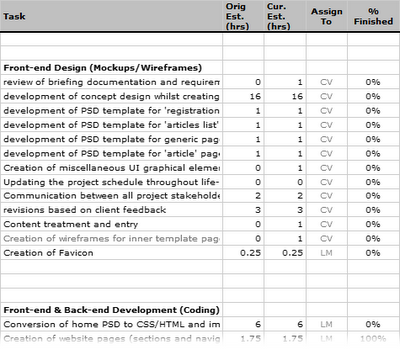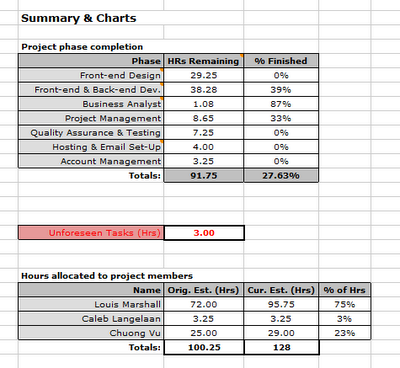Creating software without a project schedule is like driving a car without a seatbelt; it can be done, but that doesn’t mean it’s a good idea. Before we go any further, I should say that this article isn’t about why you should have a project schedule. If you need that kind of convincing, may I suggest a great article by Joel Spolsky called Painless Project Schedules. In fact, the style of project schedule I use is derived from his method.
What I would like to talk about is how Google spreadsheets can be a real treasure when it comes to making your project schedules. Like many tales, this one begins with a cause to be championed. Not so long ago, I worked at a company with three programmers. It was my job to make sure projects were delivered on time and to spec. Resources at this company were very tight. This meant that any time savings I could get by streamlining a process, I would go for.
In the past I had used either Microsoft Project or Microsoft Excel for scheduling. Putting my project schedules in Google spreadsheets offered a number of perks. For one, the schedule was accessible from anywhere anytime (home, office, mobile, etc). Another bonus was that multiple programmers could edit their relevant areas without any sharing issues. Also gone were concerns about backups and where on the company server the file should reside.

If you look at the structure of the project schedule I use, you may think to yourself “it’s so simplistic, surely that isn’t enough to cover a complex project?” But really, what more do you need? You write down what the task is, an estimate for how long it will take, who’s meant to be doing it, and how much of it has been done.
OK, you got me – this style of project schedule does have two major flaws. For starters, it’s hard to figure out delivery dates, another problem is that its tough carving out distinct milestone. But where this style or project schedule shines is in task management, you won’t miss things, and as the saying goes “the devil is in the detail”. It’s an excellent way for distributing tasks to team members. It also provides a very good overview of where you are at any given time within a project.
Personally, I tend to create my project schedules with only five phases (you can have more if you like). I’ve found all tasks will fit into one of these categories: wireframes/mockups, coding, project management, quality assurance, auxiliary tasks. Auxiliary tasks being the ‘catch-all’ for tasks which don’t neatly fit into any of the other categories.

I also like to create a ‘summary and charts’ page, but this is gilding the lily. I find that it's handy when my boss asks me “how is the Widgets project going?” I can answer “overall, its 92% done – we are on track”. Its also helpful knowing how many hours have been allocated to different team members. One reason I do this is because I have a bad habit of taking on too many technical tasks which really should be going to the production team (what can I say, I used to be a programmer).
Having a project schedule is great, but the unfortunate reality is that most people could care less about it. From my experience, upper management generally aren’t that interested in the detail of the schedule, but they do appreciate its existence. They will more often be interested in milestones and delivery dates.
The other hurdle is getting programmers to use the schedule. Most of the time I’ve found programmers aren’t too keen on directly participating in the maintenance of the schedule, but you must bring them into the fold. Programmers are far more interested in cutting code, which is good – it’s what they love to do and what they are there for. So how do you get your technical people involved in the project schedule? Basic people management skills really. People will be far more inclined to do something if you ask them to do it rather then order them to do it, and people are more inclined to do something if they are given some choice in the matter. To a lesser extend, that often vague concept of ‘ownership’ comes into play here.
What I often say to the programmers I am working with is something along these lines; “Tony, when you have time, can you please go into the project schedule and update your areas. Also, for the life of this project, I need you to go in at least once a week to update your areas”.

Over the years, I’ve found this approach works very well for a number of reasons; there is ‘choice’ in there; saying “when you have time” and “at least once a week” leaves some breathing room for people to manage themselves. People are always happier when they have options. The subtle wording; “your areas” connects to ownership. It means the project schedule belongs to them as well. Of course, never underestimate the power of manors - “thank you” and “please” always go a long way. There is a caveat with this approach however, it requires sincerity. People will spot it if you are saying something you don’t believe in.
Before I go, I would like to offer a few tips on how to construct your project schedule. When writing out the name of a task, be distinct, it should be some kind of action (e.g. “re-delegate domain name” is good, where as “undertake hosting tasks” is a little vague). Estimates for tasks should never be more then 16 hours (if they are, break it down into more tasks), but also avoid too many 0.25 hr blocks - that’s just going overboard. Do your best to fill in the ‘current estimates’ column, this can be used in future to highlight tasks you’ve underestimated.
Article reviewed by Sarah Hunt.

I plan to use similar Google spreadsheet approach for project management in small software development team. Could you post your template?
ReplyDeleteAs requested: project_schedule_example.xls
ReplyDeleteGoogle spreadsheets can be a real treasure when it comes to making your project schedules. It is very helpful for project management. I use project management software for my business project to manage properly. Keep sharing such knowledgeable post.
ReplyDelete